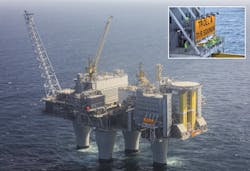Drilling & Production
Bruce Beaubouef • Houston
Shell, Equinor employ digital twin simulator for offshore Norway work
eDrilling’s team is helping Norske Shell prepare for the upcoming exploration well on the Tyttebaer prospect in the Norwegian North Sea by practicing drilling the well in a simulator using a digital twin.
Saipem’s semisubmersibleScarabeo 8 is due to spud the well 34/5-2S next month in 387 m (1,270 ft) water depth close to Norske Shell’s Knarr field.
eDrilling claims wellSim hiDRILL helps drill crews achieve safe and efficient operations for any planned well. A Digital Twin is the digital representation of the actual well. Used in real-time operation it allows the team to perform forward simulations and ‘what-if’ simulations to detect mismatch, and also provide input if necessary to alter the parameters of the well in order to optimize drilling.
The crew for Equinor’s HP/HT Ragnfrid North exploration well 6406/2-9 S in the Norwegian Sea also practiced using wellSim hiDRILL.
Their focus was on high-risk sections and likely scenarios, and the aims were to avoid hazards and improve drilling performance, eDrilling said.
Rebranding: Eldar Sætre, CEO, and Arne Sigve Nylund, Executive Vice President, Development & Production Norway for the newly branded Equinor (formerly Statoil) visit the Troll A platform to help unveil the new Equinor sign. (Photo by Ole Jørgen Bratland, courtesy Equinor)
North Sea Cara well wins innovation award
Neptune Energy’s Cara discovery in license PL636 in the Norwegian North Sea was awarded the Exploration Innovation prize at last week’s Recent Discoveries Conference in Oslo.
Cara was one of 10 nominees and one of three finalists, the others being the Kayak and Zumba wells.
Neptune’s team had set out to prove petroleum in a stratigraphic trap in the Early Cretaceous Agat formation, despite the fact that Norsk Hydro had drilled a dry well in the same license area in 2002.
In 2013-2014 the team identified and matured Cara to a drillable prospect integrating all available data, and the subsequent well, 36/7-4, drilled in summer 2016, encountered commercial volumes of oil and gas.
“The Cara discovery well is most likely a play opener as it has proven that Cretaceous sandstones can make up commercial target,” said Matthieu Vialla, Neptune’s exploration manager Northern Europe.
The discovery is 6 km (3.7 mi) northeast of the company’s Gjøa field center: the company plans further exploration on the license 636 and in surrounding blocks such as PL929, awarded under Norway’s APA 2017 round.
North Sea operators to trial subsea cementing technique
DeltaTek Global has completed two onshore field trials of its SeaCure subsea cementing system.
Following successful results, Chevron and Siccar Point Energy have agreed to conduct trials of the technology this summer in two live offshore wells, down to a depth of 5,000 ft (1,524 m), under a project backed by the Oil & Gas Technology Centre.
SeaCure delivers stabbed-in inner string cementing for subsea wells. The initial proof-of- concept trials took place in April in an onshore test well at Frank’s International’s Aberdeen base.
DeltaTek aims to initiate a full product launch in September.
CEO Tristam Horn said: “With the ability to undertake offshore cement jobs in any range of water depths, SeaCure’s inherent benefits include improved success rates of cement placement back to the seabed for conductor and surface casings, performing a pressure test of a subsea casing string prior to and post cementation, as well as entirely eliminating a clean-out run from a subsea drilling program.”
Aker BP extends software use throughout well operations department
Aker BP has expanded its use of AGR’s iQx software. Originally the operator’s drilling department used this to improve internal knowledge-sharing on its operations.
Now use of the software will be extended to all well-related knowledge management activity, including subsurface, P&A, and well intervention programs.
iQx allows operators to share information on a collaborative web-based platform, identifying problems from past projects and alerting teams to potential issues for upcoming activities.
Equinor signs Odfjell semi for long-term offshore Norway drilling program
Equinor (ex-Statoil) has contracted Odfjell Drilling’s semisubmersible Deepsea Atlantic to drill three production wells on the Fram and Askeladd licenses in the Norwegian North Sea and Barents Sea.
Value of the contract, due to start next January, is in the range of $150-200 million for six wells. In addition, Odfjell will be responsible for casing running, slop treatment and cuttings handling, ROV operations, and fuel.
Geir Tungesvik, Equinor’s Drilling & Welll svp, expected the program to take up to 18 months to complete, before a master framework agreement takes effect, under which the company will attempt to find new assignments for the rig on a continuous basis.
It is a performance-based contract, he added, designed to encourage safe and efficient operations, with an incentive to reduce carbon-dioxide emissions.
Currently the rig is working for Equinor on the Visund and Utgard licenses in the North Sea. Thereafter, it will undergo a 10-year-classification.
Early next year, it should start drilling the first of three dual multilateral wells on the Fram field, each with two branches extending from the main wellbore. It will then head north to Askeladd to drill three production wells. Operations will be supported by logistics bases at Mongstad and Hammerfest, respectively.


